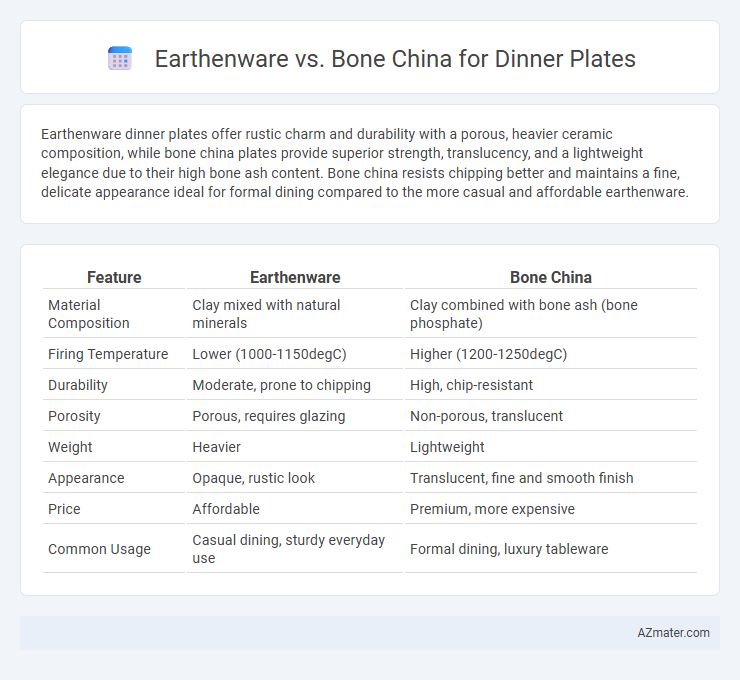Earthenware dinner plates offer rustic charm and durability with a porous, heavier ceramic composition, while bone china plates provide superior strength, translucency, and a lightweight elegance due to their high bone ash content. Bone china resists chipping better and maintains a fine, delicate appearance ideal for formal dining compared to the more casual and affordable earthenware.
Table of Comparison
| Feature | Earthenware | Bone China |
|---|---|---|
| Material Composition | Clay mixed with natural minerals | Clay combined with bone ash (bone phosphate) |
| Firing Temperature | Lower (1000-1150degC) | Higher (1200-1250degC) |
| Durability | Moderate, prone to chipping | High, chip-resistant |
| Porosity | Porous, requires glazing | Non-porous, translucent |
| Weight | Heavier | Lightweight |
| Appearance | Opaque, rustic look | Translucent, fine and smooth finish |
| Price | Affordable | Premium, more expensive |
| Common Usage | Casual dining, sturdy everyday use | Formal dining, luxury tableware |
Introduction to Earthenware and Bone China
Earthenware dinner plates are crafted from porous clay fired at lower temperatures, resulting in a rustic, sturdy finish ideal for casual dining. Bone china, made from refined clay mixed with bone ash and fired at higher temperatures, is renowned for its delicate translucency, high strength, and elegant, smooth surface. Choosing between earthenware and bone china depends on the balance between durability and sophistication desired in tableware.
Material Composition: Earthenware vs Bone China
Earthenware dinner plates are made from clay fired at lower temperatures, resulting in a porous, thicker material often coated with a glaze to prevent absorption. Bone china incorporates bone ash, feldspar, and kaolin and is fired at higher temperatures, producing a denser, more translucent, and highly durable ceramic. The inclusion of bone ash in bone china enhances strength and whiteness, making it more resistant to chipping compared to the more fragile and slightly porous earthenware.
Manufacturing Process Differences
Earthenware dinner plates are crafted from natural clay fired at lower temperatures (typically 1,000-1,150degC), resulting in a porous and thicker ceramic body that often requires glazing to improve durability and water resistance. Bone china production involves blending bone ash with kaolin and feldspar, firing at higher temperatures (around 1,200-1,300degC), which creates a stronger, more translucent, and finely vitrified material with enhanced whiteness and chip resistance. These manufacturing distinctions affect the density, translucency, and strength characteristics, making bone china more delicate yet durable, while earthenware offers a heavier, rustic appeal with less resilience to impact.
Durability and Strength Comparison
Earthenware dinner plates offer moderate durability but are more prone to chipping and cracking compared to bone china. Bone china boasts superior strength due to its high levels of bone ash, making it highly resistant to impact and everyday wear. This increased durability makes bone china a preferred choice for long-lasting, elegant dinnerware.
Aesthetic Appeal: Color, Texture, and Design
Earthenware dinner plates showcase rich, earthy tones and a rustic texture that enhances a warm, handcrafted aesthetic, often featuring vibrant glazes and artisanal patterns. Bone china plates offer a delicate, translucent quality with a smooth, glossy surface and intricate designs, epitomizing elegance and refinement. The contrast between earthenware's robust, tactile feel and bone china's sleek, sophisticated finish defines their distinct visual and tactile appeal in table settings.
Weight and Handling Ease
Earthenware dinner plates are typically heavier and thicker, providing a sturdy feel but making them less convenient to handle, especially when serving multiple courses. Bone china plates are lighter and thinner, enhancing ease of handling and offering a more delicate, elegant presentation without sacrificing durability. The lighter weight of bone china reduces hand fatigue, making it ideal for formal dining settings requiring frequent use and careful handling.
Heat Resistance and Microwave Safety
Earthenware dinner plates typically offer lower heat resistance, making them more prone to cracking under rapid temperature changes compared to bone china, which is fired at higher temperatures for enhanced durability. Bone china is generally microwave-safe due to its vitrified, non-porous structure that resists heat damage and uneven heating. Earthenware may absorb moisture and heat unevenly, increasing the risk of microwave damage and reducing its suitability for frequent microwave use.
Price Differences and Value for Money
Earthenware dinner plates generally cost significantly less than bone china, making them a budget-friendly option for everyday use. Bone china plates, while pricier due to their fine porcelain composition and durability, offer superior elegance and chip resistance that can justify the investment for special occasions. Evaluating price differences alongside longevity and aesthetic appeal helps determine the best value for money based on individual dining needs.
Maintenance and Care Guidelines
Earthenware dinner plates require gentle hand washing with mild detergents to prevent chipping, as they are more porous and less durable than bone china. Bone china dinner plates offer higher resistance to chipping and can often be safely cleaned in a dishwasher, though hand washing preserves their glaze and intricate patterns. Both materials benefit from avoiding sudden temperature changes and abrasive cleaning tools to maintain longevity and appearance.
Choosing the Right Dinner Plate for Your Needs
Earthenware dinner plates offer durability and a rustic aesthetic, making them ideal for casual dining and everyday use due to their heavier weight and less delicate nature. Bone china plates provide a refined, lightweight option with superior chip resistance and translucency, perfect for formal occasions and elegant table settings. When choosing the right dinner plate, consider the balance between practicality, aesthetic preference, and frequency of use to ensure the best fit for your dining needs.

Infographic: Earthenware vs Bone China for Dinner Plate
 azmater.com
azmater.com